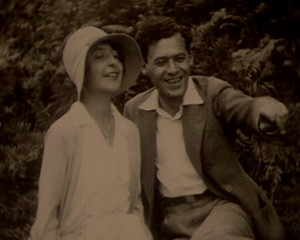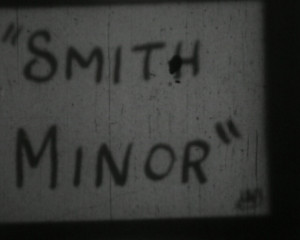
"A group of upper-middle class young men (dressed in shirts and ties, one in a striped blazer) sit on the grass. They are idle and bored and missing women. An intertitle states that `there is not a bird in sight'. A group of young women from the Amena Stich private school, led by their bespectacled female teacher, is walking out for exercise. The men see them and life looks better. They hide behind a hedge as the women pass by. The young women stray on a side path leaving their teacher to walk on alone. She eventually notices her young ladies are not behind her and goes to look for them. Meantime the men and women have met up and all sit around on the grass, the women being chatted up. Professor Stephen Chickwood is in the woods looking for insects. He meets the teacher and offers help to find her girls. They form a relationship and walk hand in hand. Eventually they come upon the young men and women who laugh and point at them. Amena shouts `Help'" (EAFA Database).

"Amateur filmmaker, cinema historian and railway engineer H.A.V. Bulleid presents a tale of brotherly rivalry. When Smith Minor - 'so little, he was lost in an Austin Seven' - is bullied by his older brother, Smith Major - 'so tough he slept on tin-tacks' - he is resolved to get revenge, once and for all. Employing the help of a friend and mutual enemy, he hatches a plan of vengeance, plotting to 'heave him over the quarry'. An altercation between two boys is followed by the introduction of Studious Stevens, 'so classical he couldn't fathom science'’ (EAFA Database)" [NOTE – EAFA database suggests this is an incomplete film].

"The third in Steiner’s trilogy of abstract films, Mechanical Principles (1930), is fascinating and more striking than Surf and Seaweed. It is composed of close-up shots of mechanical gears of different kinds in motion; rather than an examination of a single machine, it is an examination of the different kinds of motion produced by machines. Mechanical Principles emphasizes the tension in such machinery between the constancy of force and repetition on the one hand and the irregularity of shapes, sizes, and motions on the other, " Tepperman, 203.
"A film covering a motor journey made by members of the Automobile Club of Southern California during the summer of 1930.... The Land of the Golden Twilight was northern British Columbia, and the tour left from Seattle, travelling through the Cariboo to Hazelton and Kispiox. Scenes included the Stampede at Williams Lake, a dance by medicine men, and many scenic views of northern British Columbia along the highway." (Colin Browne, Motion Picture Production in British Columbia, 1898-1940 (1979), entry #1052.)
The film is listed in Browne's filmography as "With the International Caravan to the Land of the Golden Twilight."
Total Pages: 299